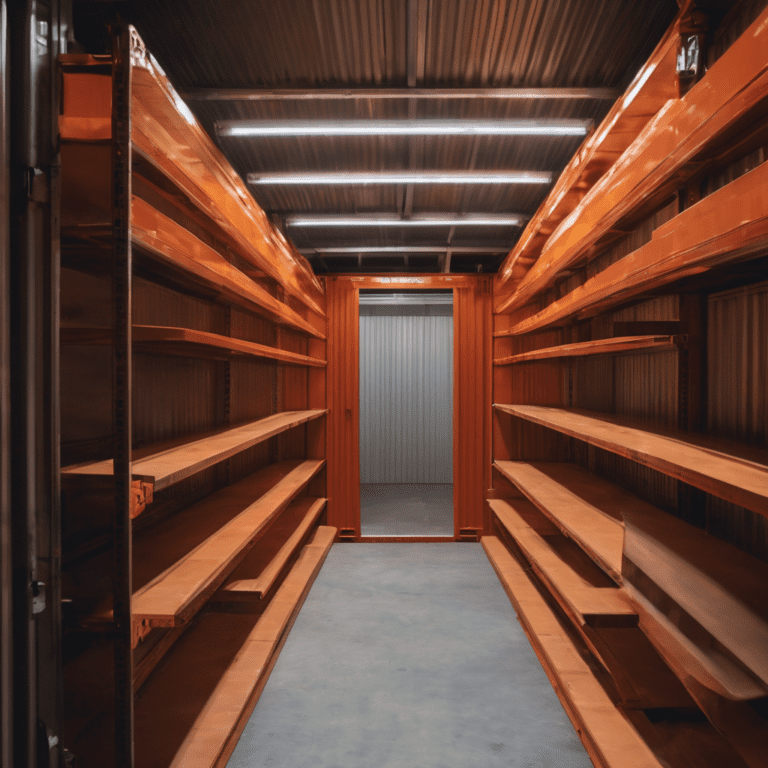How to Start a Shipping Container Self-Storage Business
Thinking about starting your own self-storage business using shipping containers? With the increasing demand for secure and flexible storage solutions, this rapidly growing sector offers a cost-effective and scalable way to enter the storage industry. Shipping containers provide a durable and versatile option, catering to various customer needs from household storage to business inventory management. Here’s a step-by-step guide on how to start a shipping container self-storage business and make it a success.

Why Choose Shipping Containers for Self-Storage?
Shipping containers have become a popular choice for self-storage businesses due to their durability, security, and affordability. They are weather-resistant, easy to transport, and require minimal construction work. Constructed from high-quality steel construction, these containers can withstand harsh environmental conditions, from heavy rain to extreme heat, ensuring the safety of stored items. The robust steel construction ensures structural integrity, reducing maintenance costs and providing long-term reliability for your self-storage business. Their modular design allows for easy stacking and reconfiguration, enabling business owners to efficiently utilize available space as their customer base grows. This makes them a perfect storage solution for anyone looking to start a storage business quickly and with a lower initial investment while having the flexibility to expand in the future. Keeping up with container market trends helps ensure you make informed decisions about your inventory.
Step 1: Conduct Thorough Market Research
Before investing, conduct thorough market research to understand the demand for self-storage in your area. Begin by analyzing local demographics and identifying key consumer segments such as homeowners, renters, businesses, and students who may require additional storage space. Evaluate the existing competition by visiting nearby storage facilities to assess their pricing structures, unit sizes, and value-added services. Research market trends within the container market and shipping container market to gauge industry growth and identify emerging demands, such as climate-controlled units or drive-up access. Knowing the shipping container market and storage containers market trends will give you a competitive edge and help you position your business effectively within the local landscape.
Step 2: Secure a Suitable Location
Finding the right location is crucial. Look for an easily accessible site with enough space for container placement, vehicle parking, and customer movement. The location should also have good road connectivity and proximity to major transportation routes to facilitate easy access for both customers and delivery trucks. Industrial or commercial zones often offer the best options, particularly those with proximity to global trade hubs, ports, or logistics centers. Additionally, consider the security of the area, ensuring it is well-lit and not prone to theft or vandalism. Access to utilities like electricity and water can also be beneficial for future expansions or container modifications.
Step 3: Purchase High-Quality Containers
Opt for high-quality containers, either new or lightly-used, to ensure durability and security. Containers come in various sizes, such as 10ft, 20ft, and 40ft, allowing you to offer different storage options to customers. Understanding container size variations is essential, as different clients may require compact units for personal belongings or larger containers for business inventory storage. Working with trusted suppliers like UC Containers can ensure you receive durable, ISO-standard containers with good resale value. UC Containers specializes in the sale of new and used shipping containers and offers flexible rent-to-own options, financing plans, and fast delivery services. With depots strategically located across the United States, including Atlanta, Houston, Miami, and many more, UC Containers ensures quick access to high-quality containers wherever you are. You can explore their full range of products and services on their website.
Inspect each container for signs of corrosion, structural damage, or door seal issues to guarantee their longevity. Additionally, consider sourcing specialized containers such as refrigerated containers or high-cube units to cater to customers with unique storage needs. Staying informed about shipping container market trends allows you to better predict price fluctuations and ensure you source containers at the right time.
Step 4: Prepare the Site and Foundation
Prepare a leveled surface, typically with gravel or concrete, to place your containers. Ensuring the site is properly prepared is vital for the long-term stability and security of your storage units. Begin by clearing the area of debris and vegetation. Use compacted gravel or a concrete pad to create a stable and level foundation, which helps prevent containers from shifting over time. Proper drainage is crucial to prevent water accumulation around and under the containers, which can lead to corrosion and structural damage. Installing a perimeter fence and security systems, such as surveillance cameras and lighting, adds an extra layer of protection against theft and vandalism. For a comprehensive guide on site preparation and ensuring safe container delivery, refer to this site preparation guide. Building a solid container foundation helps prevent structural issues in the future and ensures your self-storage business operates smoothly from the start.
Step 5: Install Containers and Customize for Versatility
Once the site is ready, place your containers according to your site plan. You can customize the units by adding ventilation, lighting, insulation, or shelving to enhance the customer experience. Container modification options like adding climate control or pest control measures improve your service offering. Logistics planning is essential during this stage to ensure the delivery and positioning of your containers is efficient and causes minimal disruption to your site.
Step 6: Obtain Permits and Comply with ISO Standards
Check local regulations and obtain the necessary permits to operate a self-storage business. Compliance with zoning laws, safety standards, and ISO standards is vital to avoid legal issues and ensure smooth operations.
Step 7: Set Competitive Pricing and Flexible Plans
Determine your pricing based on local market rates and operational costs. Offering flexible rental plans, discounts for long-term customers, or 24/7 access can attract more clients. Consider the resale value of your industrial shipping containers when evaluating your long-term investment.
Step 8: Market Your Business Using SEO and Digital Channels
Utilize digital marketing channels such as social media, Google Ads, and local directories to promote your business. Creating a user-friendly website with an online booking system can simplify the rental process for customers. Optimize your website for keywords like shipping container self-storage, modular storage containers, and container industry trends.
Step 9: Provide Security and Excellent Customer Service
A responsive and customer-friendly approach can set you apart from competitors. Clear communication, prompt issue resolution, and maintaining clean and secure units build trust and encourage repeat business. Invest in robust security measures such as surveillance cameras and automated access systems to ensure customer peace of mind.
Step 10: Scale Your Business and Stay Updated on Container Market Trends
As demand grows, reinvest in additional containers and expand your storage capacity. Stay informed on the container market, shipping container market, and container shipping industry developments to remain competitive. You can also diversify by offering container offices, mobile storage, or climate-controlled units.
FAQ
What is the resale value of shipping containers used for self-storage?
High-quality containers maintain good resale value, especially if well-maintained.
How do I ensure security for my shipping container self-storage units?
Install CCTV, fencing, and access control systems to protect customer belongings.
Are modular containers suitable for different types of storage solutions?
Yes, modular containers offer versatility for various storage needs, including climate-controlled and special-purpose containers.
What size containers should I purchase for my self-storage business?
Common sizes are 10ft, 20ft, and 40ft, catering to different storage requirements.
How important is market research before starting a self-storage business?
Market research is crucial to understand demand, competitor pricing, and customer needs in your area.
Starting a shipping container self-storage business can be a lucrative and fulfilling venture. By following these steps and staying updated on the container industry, you can establish a reliable and profitable storage solution in your community.
Internal Links to Explore Further
- How to Start a Shipping Container Rental Business
- Is Investing in Shipping Containers Profitable?
- Best Places to Buy Shipping Containers for Business
- How to Start a Shipping Container Modification Business
- ROI on Shipping Container Storage Units
- How to Lease Shipping Containers to Companies
- Shipping Container Flipping Business Guide
- Container Hotel Business Profitability
- Mobile Businesses Using Shipping Containers
Get quote!

No strings attached 💯